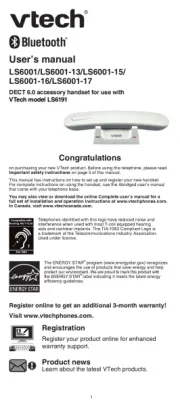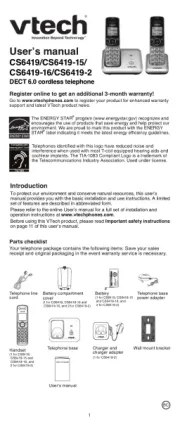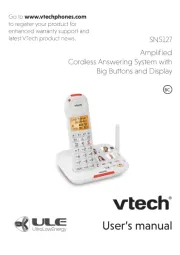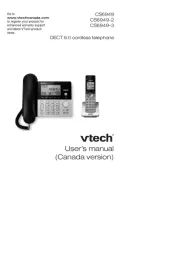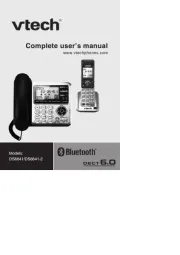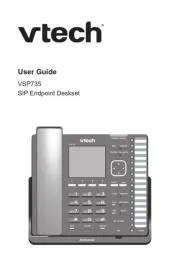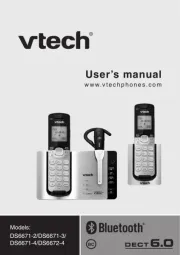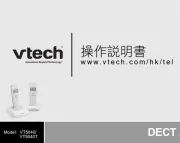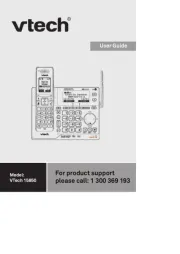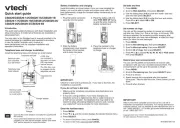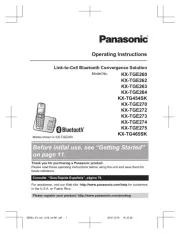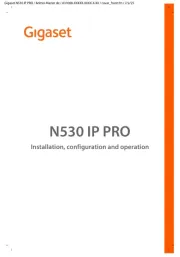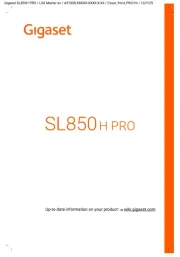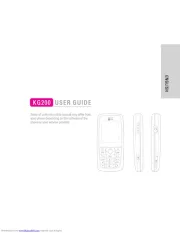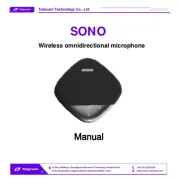
Go to www.vtechphones.com
(US) to register your product for
enhanced warranty support and
latest VTech product news.
Go to phones.vtechcanada.
com (Canada) for the latest VTech
Specifications are subject to change
© 2021 VTech Communications, Inc. |
© 2021 VTech Technologies Canada Ltd.
All rights reserved. 06/21.
DECT 6.0 accessory handset
for use with VTech models
IS8251 / IS8251-2/ IS8251-3/ IS8251-4/ IS8251-5
Important safety instructions
When using your telephone equipment, basic safety precautions should always be followed to reduce the risk of
fire, electric shock and injury, including the following:
1. Read and understand all instructions.
2. Follow all warnings and instructions marked on the product.
3. Unplug this product from the wall outlet before cleaning. Do not use liquid or aerosol cleaners. Use a damp
4. CAUTION: Do not install the telephone base at a height above 2 meters.
5. Do not use this product near water such as near a bath tub, wash bowl, kitchen sink, laundry tub or a
swimming pool, or in a wet basement or shower.
6. Do not place this product on an unstable table, shelf, stand or other unstable surfaces.
7. Avoid placing the telephone system in places with extreme temperature, direct sunlight, or other electrical
devices. Protect your phone from moisture, dust, corrosive liquids and fumes.
8. Slots and openings in the back or bottom of the telephone base and handset are provided for ventilation. To
protect them from overheating, these openings must not be blocked by placing the product on a soft surface
such as a bed, sofa or rug. This product should never be placed near or over a radiator or heat register. This
product should not be placed in any area where proper ventilation is not provided.
9. This product should be operated only from the type of power source indicated on the marking label. If you
are not sure of the type of power supply in your home or office, consult your dealer or local power company.
10. Do not allow anything to rest on the power cord. Do not install this product where the cord may be walked
11. Never push objects of any kind into this product through the slots in the telephone base or handset because
they may touch dangerous voltage points or create a short circuit. Never spill liquid of any kind on the
12. To reduce the risk of electric shock, do not disassemble this product, but take it to an authorized service
facility. Opening or removing parts of the telephone base or handset other than specified access doors may
expose you to dangerous voltages or other risks. Incorrect reassembling can cause electric shock when the
product is subsequently used.
13. Do not overload wall outlets and extension cords.
14. Unplug this product from the wall outlet and refer servicing to an authorized service facility under the
• When the power supply cord or plug is damaged or frayed.
• If liquid has been spilled onto the product.
• If the product has been exposed to rain or water.
• If the product does not operate normally by following the operating instructions. Adjust only those
controls that are covered by the operation instructions. Improper adjustment of other controls may result
in damage and often requires extensive work by an authorized technician to restore the product to
• If the product has been dropped and the telephone base and/or handset has been damaged.
• If the product exhibits a distinct change in performance.
15. Avoid using a telephone (other than cordless) during an electrical storm. There is a remote risk of electric
16. Do not use the telephone to report a gas leak in the vicinity of the leak. Under certain circumstances, a spark
may be created when the adapter is plugged into the power outlet, or when the handset is replaced in
its cradle. This is a common event associated with the closing of any electrical circuit. The user should not
plug the phone into a power outlet, and should not put a charged handset into the cradle, if the phone is
located in an environment containing concentrations of flammable or flame-supporting gases, unless there
is adequate ventilation. A spark in such an environment could create a fire or explosion. Such environments
might include: medical use of oxygen without adequate ventilation; industrial gases (cleaning solvents;
gasoline vapors; etc.); a leak of natural gas; etc.
17. Only put the handset of your telephone next to your ear when it is in normal talk mode.
18. The power adapter is intended to be correctly oriented in a vertical or floor mount position. The prongs
are not designed to hold the plug in place if it is plugged into a ceiling, under-the-table or cabinet outlet.
19. For pluggable equipment, the socket-outlet shall be installed near the equipment and shall be easily
20. CAUTION: Use only the batteries indicated in this manual. There may be a risk of
explosion if a wrong type of battery is used for the handset. Use only the supplied
rechargeable batteries or replacement batteries (BT162342/BT262342) for the handset.
Do not dispose of batteries in a fire. They may explode.
21. Use only the adapter included with this product. Incorrect adapter polarity or voltage can seriously damage
22. Base unit power adapter: Output: 6V DC @ 600mA.
23. Charger power adapter: Output: 6V DC @ 400mA.
• Use only the batteries provided or equivalent. To order a replacement, visit our website at www.vtechphones.
com or call 1 (800) 595-9511.
• In Canada, go to phones.vtechcanada.com or call 1 (800) 267-7377.
• Do not dispose of the battery in a fire. Check with local waste management codes for special disposal
• Do not open or mutilate the battery. Released electrolyte is corrosive and may cause burns or injury to the
eyes or skin. The electrolyte may be toxic if swallowed.
• Exercise care in handling batteries in order not to create a short circuit with conductive materials.
• Charge the battery provided with this product only in accordance with the instructions and limitations
Precautions for users of implanted cardiac pacemakers
Cardiac pacemakers (applies only to digital cordless telephones):
Wireless Technology Research, LLC (WTR), an independent research entity, led a multidisciplinary evaluation of
the interference between portable wireless telephones and implanted cardiac pacemakers. Supported by the U.S.
Food and Drug Administration, WTR recommends to physicians that:
• Should keep wireless telephones at least six inches from the pacemaker.
• Should NOT place wireless telephones directly over the pacemaker, such as in a breast pocket, when it is
• Should use the wireless telephone at the ear opposite the pacemaker.
WTR’s evaluation did not identify any risk to bystanders with pacemakers from other persons using wireless
About cordless telephones
• Privacy: The same features that make a cordless telephone convenient create some limitations. Telephone
calls are transmitted between the telephone base and the cordless handset by radio waves, so there is a
possibility that the cordless telephone conversations could be intercepted by radio receiving equipment
within range of the cordless handset. For this reason, you should not think of cordless telephone
conversations as being as private as those on corded telephones.
• Electrical power: The telephone base of this cordless telephone must be connected to a working electrical
outlet. The electrical outlet should not be controlled by a wall switch. Calls cannot be made from the cordless
handset if the telephone base is unplugged, switched off or if the electrical power is interrupted.
• Potential TV interference: Some cordless telephones operate at frequencies that may cause interference
to televisions and VCRs. To minimize or prevent such interference, do not place the telephone base of
the cordless telephone near or on top of a TV or VCR. If interference is experienced, moving the cordless
telephone farther away from the TV or VCR often reduces or eliminates the interference.
• Rechargeable batteries: Exercise care in handling batteries in order not to create a short circuit with
conducting material such as rings, bracelets and keys. The battery or conductor may overheat and cause
harm. Observe proper polarity between the battery and the battery charger.
• Nickel-metal hydride rechargeable batteries: Dispose of these batteries in a safe manner. Do not burn or
puncture the battery. Like other batteries of this type, if burned or punctured, they could release caustic
material which could cause injury.
This power conserving technology reduces power consumption for optimal battery performance. The ECO mode
activities automatically whenever the handset is synchronized with the telephone base.
Mesures de sécurité importantes
Afin de réduire les risques d’incendie, de blessures corporelles ou d’électrocution, suivez toujours ces
mesures préventives de base lorsque vous utilisez votre téléphone :
1. Lisez et comprenez bien toutes les instructions.
2. Observez toutes les instructions et mises en garde inscrites sur l’appareil.
3. Débranchez ce téléphone de la prise murale avant de le nettoyer. N’utilisez pas de nettoyeurs liquides ni en
aérosol. N’utilisez qu’un chiffon doux et légèrement humecté.
4. ATTENTION: Ne pas installer le socle téléphonique à une hauteur supérieure à 2 mètres.
5. N’utilisez pas ce produit près de l’eau, tel que près d’un bain, d’un lavabo, d’un évier de cuisine, d’un bac de
lavage ou d’une piscine, ou dans un soussol humide ou sous la douche.
6. Ne déposez pas ce téléphone sur un chariot, support ou table chancelants. L’appareil pourrait tomber et
être sérieusement endommagé.
7. Évitez d’installer le système téléphonique dans les endroits soumis à une température extrême, à la lumière
directe du soleil ou à proximité immédiate d’autres appareils électriques ou électroniques. Protégez votre
téléphone contre les sources d’humidité, la poussière, les vapeurs et les liquides corrosifs.
8. Le boîtier de l’appareil est doté de fentes et d’ouvertures d’aération situées à l’arrière ou en dessous. Afin
d’empêcher la surchauffe, ces ouvertures ne doivent pas être obstruées en plaçant l’appareil sur un lit, divan,
tapis ou autre surface similaires. Ne placez pas cet appareil proximité d’un élément de chauffage ni d’une
plinthe électrique. De plus, ne l’installez pas dans une unité murale ou un cabinet fermé qui ne possède
9. Ne faites fonctionner cet appareil qu’avec le type d’alimentation indiqué sur les étiquettes de l’appareil.
Si vous ne connaissez pas le voltage de votre maison, consultez votre marchand ou votre fournisseur
10. Ne déposez rien sur le cordon d’alimentation. Installez cet appareil dans un endroit sécuritaire, là où
personne ne pourra trébucher sur la ligne d’alimentation ni le cordon téléphonique modulaire.
11. N’insérez jamais d’objets à travers les fentes et ouvertures de cet appareil, car ils pourraient toucher à des
points de tension dangereux ou court-circuiter des pièces, ce qui constituerait un risque d’incendie ou
d’électrocution. N’échappez pas de liquides dans l’appareil.
12. Afin de réduire les risques d’électrocution, ne démontez pas l’appareil, mais apportez-le plutôt à un
centre de service qualifié s’il doit être réparé. En enlevant le couvercle, vous vous exposez à des tensions
dangereuses ou autres dangers similaires. Un remontage inadéquat peut être à l’origine d’une électrocution
lors d’une utilisation ultérieure de l’appareil. Débranchez l’appareil avant de procéder au nettoyage. Utilisez
un chiffon humide et doux.
13. Ne surchargez pas les prises de courant et les rallonges.
14. Débranchez cet appareil de la prise de courant et communiquez avec le département de service à la clientèle
de VTech dans les cas suivants:
• Lorsque le cordon d’alimentation est endommagé ou écorché. • Si du liquide a été échappé dans
• Si l’appareil a été exposé une source d’humidité telle que la pluie ou l’eau.
• Si le produit ne fonctionne pas normalement en respectant les instructions de fonctionnement. Réglez
uniquement les commandes indiquées dans le les instructions de fonctionnement. Les réglages
incorrects des autres commandes pourraient provoquer un dommage qui pourrait exiger un travail
exhaustif de la part d’un technicien autorisé afin de rétablir le fonctionnement normal de l’appareil.
• Si le produit a été échappé et que le socle et/ ou le combiné a été endommagé.
• Si le produit affiche une nette diminution de sa performance.
15. Évitez d’utiliser un téléphone (autre qu’un sans fil) pendant un orage. Les éclairs peuvent être à l’origine
16. N’utilisez pas le téléphone pour rapporter une fuite de gaz à proximité de la fuite. En certaines circonstances,
une flammèche pourrait être provoquée lorsque l’adaptateur est branché à une prise de courant, ou
lorsque le combiné est déposé sur le socle. Ceci est un événement commun associé à la fermeture d’un
circuit électrique. L’utilisateur ne devrait pas brancher le téléphone à une prise de courant, et ne devrait pas
déposer le combiné chargé sur le socle, si le téléphone se trouve à proximité d’un endroit comportant des
concentrations de gaz inflammables, moins que la ventilation soit adéquate. Une flammèche dans un tel
endroit pourrait provoquer un incendie ou une explosion. De tels environnements peuvent comprendre:
des endroits où l’on utilise de l’oxygène médical sans ventilation adéquate; des gaz industriels (dissolvants de
nettoyage, des vapeurs d’essence, etc.); une fuite de gaz naturel, etc.
17. Ne placez que le combiné de votre téléphone près de votre oreille lorsqu’en mode de conversation.
18. Ces adaptateurs ont été conçus pour être orientés en position verticale ou montés au sol. Les broches ne
sont pas conçues pour maintenir l’adaptateur en place si celui-ci est barnché dans une prise au plafond ou
19. Pour le MATERIEL RACCORDE PAR PRISE DE COURANT, le socle de prise de courant doit etre installe a
proximite du materiel et doit etre aisement accessible.
20. MISE EN GARDE: Il peut y avoir un risque d’explosion si vous utilisez le mauvais type de
piles pour le téléphone. N’utilisez que les piles rechargeable inclus ou les piles de
rechange (BT162342/BT262342). N’incinérez pas les piles. Celles-ci risqueraient
21. N’utilisez que les adaptateurs inclus avec ce produit. L’utilisation d’un adaptateur dont la polarité ou la tension
serait inadéquate risque d’endommager sérieusement le produit et mettre votre sécurité en péril.
22. Socle : 6 V DC @ 600 mA
23. Chargeur : 6 V DC @ 400 mA
CONSERVEZ CES INSTRUCTIONS
• N’utilisez que la pile incluse ou l’équivalent. Pour commander une pile de recharge, visitez notre site Web au
www.vtechphones.com ou composez le 800-595-9511.
• Au Canada, visitez le phones. phones.vtechcanada.com ou composez le 800-267-7377.
• Ne jetez pas la pile au feu. Vérifiez les instructions spécifiques de mise aux rebus auprès des autorités locales.
• N’ouvrez pas et ne mutilez pas la pile. L’électrolyte qui s’en échapperait est corrosif et pourrait causer des
brûlures ou des blessures aux yeux ou à la peau. L’électrolyte est toxique si avalé.
• Soyez prudents lorsque vous manipulez les piles afin d’éviter les courts-circuits provoqués par des matériaux
• Rechargez la pile incluse avec cet appareil, selon les instructions et limites spécifiées dans ce guide
Stimulateurs cardiaques implantés dans l’organisme
Les simulateurs cardiaques (s’applique uniquement aux téléphones numériques sans fil):
L’organisme ‘Wireless Technology Research, LLC (WTR)’, une firme de recherche indépendante, a mené une
évaluation pluridisciplinaire des interférences entre les téléphones sans fil portatifs et les stimulateurs cardiaques
implantés dans l’organisme. Appuyée par l’Administration des aliments et drogues (FDA) des États-Unis, la firme
WTR recommande aux médecins:
Avis aux détenteurs de stimulateurs cardiaques
• Ils doivent tenir le téléphone sans fil à une distance d’au moins six pouces du stimulateur cardiaque.
• Ils ne doivent PAS placer le téléphone sans fil directement sur le stimulateur cardiaque, tel que dans une
poche de chemise, lorsque celui-ci est en marche.
• Ils doivent utiliser le téléphone sans fil en l’appuyant sur l’oreille qui se trouve dans la direction opposée
au stimulateur cardiaque.
L’étude effectuée par l’organisme WRS n’a pas identifié de risque pour les détenteurs de simulateurs cardiaques
causés par les gens qui utilisent un téléphone sans fil à proximité de ceux-ci.
À propos des téléphones sans fil
• Alimentation électrique: Les mêmes caractéristiques qui constituent des avantages pour les téléphones sans
fil affichent également des restrictions. Les appels téléphoniques sont transmis entre le combiné sans fil et
le socle par le biais d’ondes radio ; il y a donc la possibilité que vos conversations téléphoniques sans fil
soient interceptées par des équipements de réception radio se trouvant dans la portée du combiné sans
fil. Pour cette raison, vous ne devez pas percevoir les communications téléphoniques sans fil comme étant
• Alimentation électrique: Le socle de ce téléphone sans fil doit être branché à une prise électrique
fonctionnelle. La prise électrique ne doit pas être contrôlée par un interrupteur mural. Les appels ne pourront
pas être effectués du combiné sans fil si le socle est débranché ou mis hors tension ou si le courant est coupé.
• Possibilité d’interférences aux téléviseurs: Certains téléphones sans fil fonctionnent sur des fréquences
pouvant causer des interférences aux téléviseurs et aux magnétoscopes. Pour réduire ou prévenir de telles
interférences, ne placez pas le socle du téléphone sans fil près ou sur un téléviseur ou magnétoscope. S’il y a
présence de parasites, il est conseillé d’éloigner le téléphone sans fil du téléviseur ou du magnétoscope afin
de réduire possiblement les interférences.
• Piles rechargeables: Manipulez les piles avec soin afin de ne pas les court-circuiter avec des bagues, bracelets
ou clés. Les piles ou le conducteur peut surchauffer et causer des blessures. Respectez la polarité adéquate
entre la pile et le chargeur.
• Les bloc-piles rechargeables à l’hydrure métallique de nickel: Jetez ces blocs-piles de manière écologique
et sécuritaire. Ne les incinérez pas et ne les percez pas. Tel que les autres piles de ce type, elles pourraient
dégager une matière toxique qui peut causer des blessures corporelles si elles sont brûlées ou percées.
The RBRC® seal on the nickel-metal hydride battery indicates that VTech Communications, Inc. is
voluntarily participating in an industry program to collect and recycle these batteries at the end of
their useful lives, when taken out of service within the United States and Canada.
The RBRC® program provides a convenient alternative to placing used nickel-metal hydride
batteries into the trash or municipal waste, which may be illegal in your area.
VTech’s participation in RBRC® makes it easy for you to drop off the spent battery at local retailers
participating in the RBRC® program or at authorized
VTech product service centers. Please call 1 (800) 8 BATTERY® for information on Ni-MH battery recycling and
disposal bans/restrictions in your area.
VTech’s involvement in this program is part of its commitment to protecting our environment and conserving natural
RBRC® and 1 (800) 8 BATTERY® are registered trademarks of Call2recycle, Inc.
FCC, ACTA and IC regulations
This equipment has been tested and found to comply with the requirements for a Class B digital device under
Part 15 of the Federal Communications Commission (FCC) rules. These requirements are intended to provide
reasonable protection against harmful interference in a residential installation. This equipment generates, uses and
can radiate radio frequency energy and, if not installed and used in accordance with the instructions, may cause
harmful interference to radio communications. However, there is no guarantee that interference will not occur in a
particular installation. If this equipment does cause harmful interference to radio or television reception, which can
be determined by turning the equipment off and on, the user is encouraged to try to correct
the interference by one or more of the following measures:
• Reorient or relocate the receiving antenna.
• Increase the separation between the equipment and receiver.
• Connect the equipment into an outlet on a circuit different from that to which the receiver is connected.
• Consult the dealer or an experienced radio/TV technician for help.
Changes or modifications to this equipment not expressly approved by the party responsible for compliance could
void the user’s authority to operate the equipment.
This device complies with Part 15 of the FCC rules. Operation is subject to the following two conditions:
(1) this device may not cause harmful interference, and
(2) this device must accept any interference received, including interference that may cause undesired
operation. Privacy of communications may not be ensured when using this telephone.
To ensure safety of users, the FCC has established criteria for the amount of radio frequency energy that can be
safely absorbed by a user or bystander
according to the intended usage of the product. This product has been tested and found to comply with the FCC
criteria. The handset may be safely held
against the ear of the user. The telephone base shall be installed and used such that parts of the user’s body
other than the hands are maintained at a distance of approximately 20 cm (8 inches) or more.
This Class B digital apparatus complies with Canadian requirement: CAN ICES-3 (B)/NMB-3(B).
This equipment complies with Part 68 of the FCC rules and with technical requirements adopted by the
Administrative Council for Terminal Attachments (ACTA). The label on the back or bottom of this equipment contains,
among other things, a product identifier in the format US:AAAEQ##TXXXX. This identifier must be provided to your
telephone service provider upon request.
The plug and jack used to connect this equipment to premises wiring and the telephone network must comply
with applicable Part 68 rules and technical requirements adopted by ACTA. A compliant telephone cord and
modular plug is provided with this product. It is designed to be connected to a compatible modular jack that is also
compliant. An RJ11 jack should normally be used for connecting to a single line and an RJ14 jack for two lines. See
the installation instructions in the user’s manual.
The Ringer Equivalence Number (REN) is used to determine how many devices you may connect to your telephone
line and still have them ring when you are called. The REN for this product is encoded as the 6th and 7th characters
following the US: in the product identifier (e.g., if ## is 03, the REN is 0.3). In most, but not all areas, the sum of all
RENs should be five (5.0) or less. For more information, please contact your telephone service provider.
This equipment may not be used with Party Lines. If you have specially wired alarm dialing equipment connected to
your telephone line, ensure the connection of this equipment does not disable your alarm equipment. If you have
questions about what will disable alarm equipment, consult your telephone service provider or a qualified installer.
If this equipment is malfunctioning, it must be unplugged from the modular jack until the problem has been
corrected. Replacement to this telephone equipment can only be made by the manufacturer or its authorized
agents. For replacement procedures, follow the instructions outlined under the “Limited warranty”.
If this equipment is causing harm to the telephone network, the telephone service provider may temporarily
discontinue your telephone service. The telephone service provider is required to notify you before interrupting
service. If advance notice is not practical, you will be notified as soon as possible. You will be given the opportunity
to correct the problem and the telephone service provider is required to inform you of your right to file a complaint
with the FCC. Your telephone service provider may make
changes in its facilities, equipment, operation, or procedures that could affect the proper functioning of this
product. The telephone service provider is required to notify you if such changes are planned.
If this product is equipped with a corded or cordless handset, it is hearing aid compatible. If this product has
memory dialing locations, you may
choose to store emergency telephone numbers (e.g., police, fire, medical) in these locations. If you do store or test
emergency numbers, please:
Remain on the line and briefly explain the reason for the call before hanging up.
Perform such activities in off-peak hours, such as early morning or late evening.
This device contains licence-exempt transmitter(s)/receiver(s) that comply with Innovation, Science and Economic
Development Canada’s licence-exempt RSS(s).
Operation is subject to the following two conditions:
(1) this device may not cause interference, and (2) this device must accept any interference, including interference
that may cause undesired operation. Privacy of communications may not be ensured when using this telephone.
The term ‘’IC:‘’ before the certification/registration number only signifies that the Industry Canada technical
The Ringer Equivalence Number (REN) for this terminal equipment is 1.0. The REN is an indication of the maximum
number of devices allowed to be connected to a telephone interface. The termination on an interface may consist
of any combination of devices subject only to the requirement that the sum of the RENs of all the devices does
This product meets the applicable Innovation, Science and Economic Development Canada technical specifications.
California Energy Commission Battery charging testing instructions
This telephone is set up to comply with the energy-conserving standards right out of the box. These instructions are
intended for California Energy Commission (CEC) compliance testing only. When the CEC battery charging testing
mode is activated, all telephone functions, except battery charging, will be disabled.
To activate the CEC battery charging testing mode:
1. Unplug the telephone base power adapter from the power outlet. Make sure all handsets are plugged with
charged batteries before proceeding.
2. press and hold , plug the telephone base power adapter back to the power outlet.While you FIND HS
3. After about 20 seconds, when the light starts flashing, release and then press it again HOME FIND HS
within two seconds. You hear a confirmation tone. The light turns on and all handsets display HOME To
register HS... see manual alternately. Allow up to one minute for the process to complete.
If the phone fails to enter this mode, repeat all the steps mentioned above. The telephone base will be powered up
as normal if you fail to press within two seconds in Step 3.FIND HS
To deactivate the CEC battery charging testing mode:
1. Unplug the telephone base power adapter from the power outlet, and then plug it back in. Then the
telephone base is powered up as normal.
2. Put the handsets on the telephone base cradle to begin registration.
3. The handset shows Registering... If the registration is successful, the handset screen displays and Registered
beeps. The handset is registered with the telephone base.
